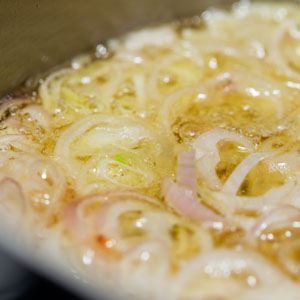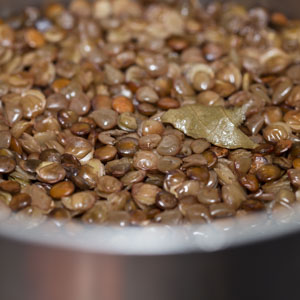Mujadara

introduction
We might be faulted for occasional BASE jumping when it comes to foundation foods like rice and peas, risi e bisi, and kedgeree (kedgeree in its original iteration as a foodway of India—before the Brits got their hands on it and took the pulses out). What fascinates us in particular is the persisting affinity between rice and peas. Sure, rice is a cereal and peas are legumes, but they grow in sequence or together to keep the soil, plants, and humans healthy. Their camaraderie comes down to the principle of good tilth: healthy soil makes healthy crops makes healthy people.
Welcome to freefall mujadara—the oldest drop-dead simple cereal and legume dish emanating from Middle Eastern and Indian culinary cultures. Mujadara is basic: lowly lentils and rice with caramelized onions. But there is nothing basic or lowly about this mujadara—and here’s why.
First, we chose Anson Mills Charleston Gold Brown Rice (brown because its bran layers and germ have not been polished away), a cross between Carolina Gold and a long-grain heirloom aromatic rice. Compellingly scented and delicately nutty, Charleston Gold Brown—which cooks up nearly white, by the way—also brings cheerful springy texture to the mujadara grouping and maintains its presence, in terms of flavor and texture, amid lentils, onions, and spice.
Nuance number two: sprouted green lentils. Sprouted green lentils (available to purchase dried and already sprouted) have a clean sweetness and distinctly unstarchy texture that we consider greatly superior to plain old dusty dried brown lentils.
Nuance number three: fried shallots. Onions figure prominently in mujadara, but fried shallots transform it. Hot oil turns shallot slices into crisp onion candy. So delicious are they one could eat them straight from a bowl with a spoon, abandoning their garnish function altogether (and, shamefully, we have done this).
Additionally, we discovered that this dish argued persuasively in favor of cooking its various components individually—à point, of course—and combining them at the end. Let us not neglect to mention the lush appeal of the crown of yogurt—tart, creamy, chilly—to offset the richly flavored center of the dish, sprinkled lavishly with the aforementioned fried shallots.
Cooking Remarks
A reminder here to take it easy on the rice while it’s cooking. We tend to think of brown rice as a rough and tumble grain, but this fresh, new crop specimen prefers a gentle simmer.
The sprouted green lentils we found are by truRoots Organic. They’re worth seeking out.
Mujadara is particularly tasty with Baba Ghanoush.
equipment mise en place
For the shallots, you will need paper towels, a plate, a large fine-mesh strainer, a large heatproof bowl, a 12- to 14-inch wok or medium heavy-bottomed saucepan, and an instant-read thermometer.
For the rice, you will need a heavy-bottomed 3-quart saucepan, a large skillet, and a fine-holed colander.
For the lentils, you will need a heavy-bottomed medium saucepan.
-
for the fried shallots:
-
1pound shallots, peeled but left whole
-
1¼cups rice oil or grapeseed oil
-
A big pinch of fine sea salt
-
-
for the rice:
-
1
-
½Turkish bay leaf
-
A big pinch of fine sea salt
-
-
for the caramelized onion:
-
2tablespoons extra-virgin olive oil
-
1large onion, finely chopped (about 2 cups)
-
½teaspoon fine sea salt
-
½teaspoon freshly ground black pepper
-
¼teaspoon ground allspice
-
-
for the lentils:
-
1½cups spring or filtered water
-
Tiny piece of Turkish bay leaf
-
½teaspoon fine sea salt
-
1teaspoon olive oil
-
1cup sprouted green lentils (see Cooking Remarks)
-
-
for serving:
-
Fine sea salt and freshly ground black pepper (optional)
-
1cup plain Greek yogurt
-
-
Fry the shallots: Slice the shallots into thin rings—you should have about 3 cups (fig. 1.1). Line a plate with several thicknesses of paper towels and set a large fine-mesh strainer over a large heatproof bowl. Heat the oil over medium heat in a 12- to 14-inch-inch wok or medium heavy-bottomed saucepan until it registers 325 degrees on an instant-read or deep-fry thermometer. Add the shallots all at once, increase the heat to medium-high, and stir well (we like using a wooden chopstick to stir). Fry the shallots, stirring frequently and adjusting the heat as needed to maintain a gentle but steady bubbling action (fig. 1.2), until they begin to turn golden, at least 10 minutes. Decrease the heat to medium and fry, stirring constantly, until the shallots are rich golden brown, 10 to 12 minutes more. Watch out during the last few minutes, particularly if you’re using an enameled cast-iron saucepan that really captures and retains heat. Immediately drain the shallots in the fine-mesh strainer, and then shake the strainer a few times to help the shallots release as much oil as possible. Turn the shallots out onto to the prepared plate (fig. 1.3) and sprinkle with the salt. Set aside until ready to use. Let the oil cool and discard.
-
Cook the rice: Fill a heavy-bottomed medium saucepan three-fourths full of water and bring to a boil over high heat. Add the rice, bay leaf, and the salt, and stir once or twice. Cover the pot halfway, reduce the heat to maintain a nice civilized simmer, and cook until the rice is just tender, about 2o minutes. Do not forcefully boil the rice! Drain the rice in a fine-holed colander set in the sink, discard the bay leaf, and refresh the rice with running cool water. Shake the colander well and set the rice aside.
-
While the rice cooks, caramelize the onion: Heat the oil in a large skillet over medium heat until shimmering. Add the onion, salt, pepper, and allspice and cook, stirring frequently, until the onion is caramelized, about 10 minutes (fig. 3.1). Remove the skillet from the heat and set aside.
-
Cook the lentils: Bring the water, bay leaf, salt and oil to a boil in a medium heavy-bottomed saucepan over high heat. Add the lentils. Swirl the pan, reduce heat to medium-low, and cover tightly. Cook until the lentils have absorbed the water and are plump and tender, but retain a trace of firmness at their center, about 20 minutes. Remove from the heat and let the pot sit, covered, for 5 minutes (fig. 4.1). Discard the bay leaf.
-
To finish the mujadara, toss the cooked rice and the lentils into the skillet with the caramelized onion. Cook over medium heat, stirring gently to combine, until warmed through, 2 to 3 minutes (fig. 5.1); if the mixture appears dry, sprinkle in a tablespoon or two of water. Taste for seasoning and adjust to your taste. Add 1 cup of the fried shallots and stir to evenly distribute. Turn the mujadara into a large serving bowl. Pass the yogurt and the remaining fried shallots separately. Alternatively, spoon the mujadara onto individual plates and garnish with the yogurt and remaining fried shallots.
-
-
1.1

-
1.2

-
1.3

-
-
-
3.1

-
-
-
4.1

-
-
-
5.1

-